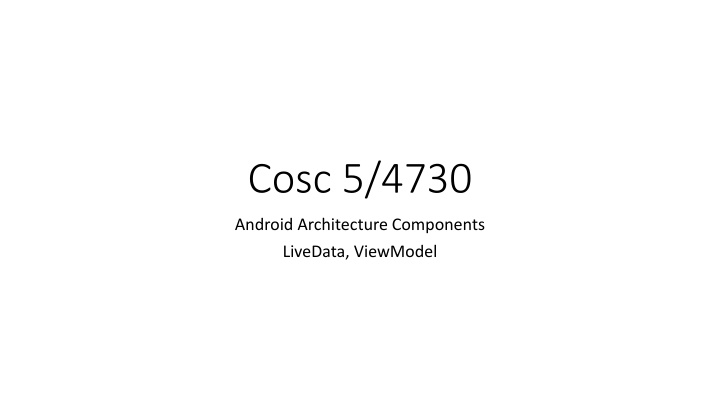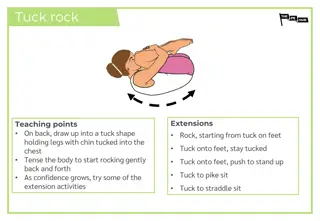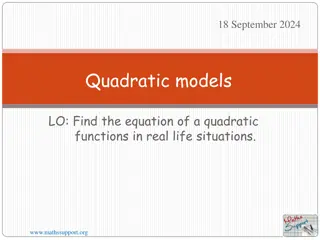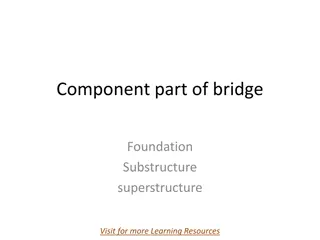
Android Architecture Components: LiveData and ViewModel
Explore LiveData and ViewModel in Android architecture components, allowing data storage outside activities for easy access across fragments and activities. Learn about implementing ViewModel, dependencies, and sharing data efficiently within your Android app.
Download Presentation

Please find below an Image/Link to download the presentation.
The content on the website is provided AS IS for your information and personal use only. It may not be sold, licensed, or shared on other websites without obtaining consent from the author. If you encounter any issues during the download, it is possible that the publisher has removed the file from their server.
You are allowed to download the files provided on this website for personal or commercial use, subject to the condition that they are used lawfully. All files are the property of their respective owners.
The content on the website is provided AS IS for your information and personal use only. It may not be sold, licensed, or shared on other websites without obtaining consent from the author.
E N D
Presentation Transcript
Cosc 5/4730 Android Architecture Components LiveData, ViewModel
Architecture Components Lifecycle LiveData and ViewModel with LifecycleObservers and LifecyclerOwner ViewModel is where data can now be stored outside of the activity. and It can be referenced in the layout as well. You don't necessary need callbacks, because all the fragment in an activity will have access to the same ViewModel data. Combining LiveData with a ViewModel, we introduce the first of many "G Magic" actions The screen can be set to "auto" update when data is changed at in ViewModel in another fragment or even an activity.
Adding to dependencies In the Dependencies section of the build just ViewModel implementation "androidx.lifecycle:lifecycle-viewmodel:2.8.4" just LiveData implementation "androidx.lifecycle:lifecycle-livedata:2.8.4" Normally you want to include both.
ViewModel (version 2.4+) as a POJO
ViewModel At its core, it just a the POJO (Plain Old Java Object) Example: ViewModelDemo Public class DataViewModel extends ViewModel { int count=0; myObject stuff; //a java object you created. private string myString; //a string. Provide get and set methods for the data just like always. }
ViewModel (2) Declare the viewModel in the activity, fragment, etc to use them DataViewModel mViewModel; mViewModel = new ViewModelProvider(this).get(DataViewModel.class); Where this is the activity. Fragments use requireActivity() kotlin: val mViewModel = ViewModelProvider(this).get(DataViewModel::class.java) Note, the model DOES NOT need to be in java. Even in kotlin, uses the same class.java. This ViewModel now exists in the activity, but it is separate. It can be accessed by activity and all it fragments very easily. We now have a shared "memory" space of variables. Now, we have a set of shared data per screen. There are ways to share between activities, but it's much more complex and needs a viewModelFactory.
ViewModel (3) Now you use the ViewModel, just like any data object. learns into the MVC The main difference it that every fragment and the activity will see the same data and the variable is local to the fragments and activity.
ViewModel (4) Constructors and a weird problem. While we can have constructors if you use just a ViewModel When combined with a LiveData object and observers. The constructors can not be called. You will need to create a viewModelFactory that could need call the constructor.
Do not pass context into ViewModel Never pass context into ViewModel instances Do not store Activity, Fragment, or View instances or their Context in the ViewModel An Activity can be destroyed and created many times during the lifecycle of a ViewModel If you need application context, inherit from AndroidViewModel It's a modelView that has a constructor that gets application context and can call getApplicationContext(). you can change any ViewModel to and AndroidViewModel.
ViewModel does not survive app closure ViewModel survives configuration changes, but not app shutdown We will come back to saving data later on.
LiveData LiveData is lifecycle-aware, meaning it respects the lifecycle of other app components, such as activities, fragments, or services. This awareness ensures LiveData only updates app component observers that are in an active lifecycle state. easy to make sure the data is always update without worrying about lifecycle changes, including across activates, fragments, and services. Use with a ViewModel to setup java Object like you normally would. Uses a method, setValue Which will then trigger any observers to deal with new data. Use the MutableLiveData<> object.
example For a String MutableLiveData<String> myString To change the data and trigger the observers myString.setValue("hi there"); To retrieve the value String temp = myString.getValue(); It's required that you use the setValue and getValue. Otherwise the observers will not be triggered.
ViewModel and LiveData Use liveData with the ViewModel to provide an easy way to add observers. Public class DataViewModel extends ViewModel { private MutableLiveData<dataObj> data; //POJO private MutableLiveData<String> myString; //a string. Provide get and set methods for the data they should use the getValue and setValue methods. }
ViewModel and LiveData (2) We also need to provide a method for the observers. it needs to return a LiveData<object> for each MutableLiveData. example: public LiveData<String> getStr() { Since no constructors, this is a better solution: public LiveData<dataObj> getData() { if (data == null) { data = new MutableLiveData<dataObj>(); data.setValue(new dataObj()); } return data; } return myString; }
MainActivity/fragment and Observers Delcare the viewModel in the activity, fragment, etc to use them DataViewModel mViewModel; mViewModel = new ViewModelProvider(this).get(DataViewModel.class); Where this could the activity, fragment in a fragment, change to requireActivity() And declare the observer and action. mViewModel.getData().observe(this, new Observer<dataObj>() { @Override public void onChanged(@Nullable dataObj data) { tv_count.setText(data.getCount()); //where tv_count is a text view. } }); To change the data call the setter mViewModel.setCount(3); //for example, set count to 3. This will trigger the observer above to change the textView count as well.
ViewModel (3) Since there is an instance of your ViewModel, Changing the example setcount to 3, could also update the activity and any fragments, plus services. If they are foreground, otherwise they will be notified when they become active again. This assumes they have declared observers in each as well. Any new fragments/services would also get the data as they start. Example: liveDataDemo
QA &















![Legal Dispute Analysis: FCA v ARCH and Others [2021] UKSC 1](/thumb/189783/legal-dispute-analysis-fca-v-arch-and-others-2021-uksc-1.jpg)






